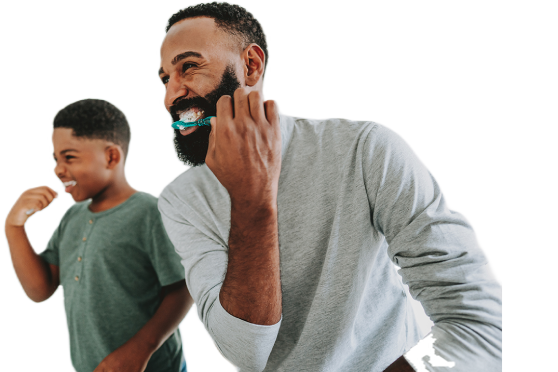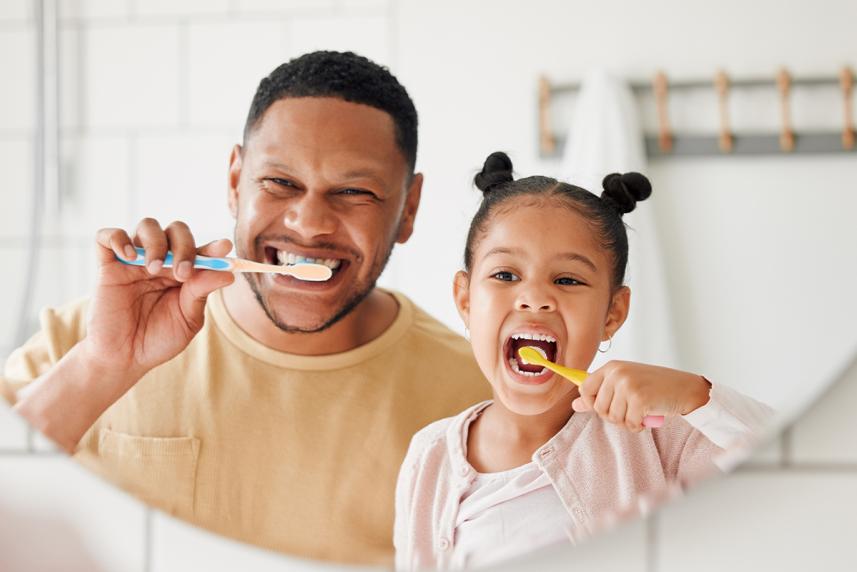
Your Premier Access plan makes it easy. No travel. No scheduling hassles. No additional cost to you! Click below to find your school and sign up.*
*You’ll be directed to MySchoolDentist to complete a permission form.
Signing up for this essential health checkup means your child can see the dentist with their friends and not miss any school.

It is never too early to start talking to your child about their in-school dental appointment. Explaining what will happen during their visit can help them become familiar with the checkup and ease some of their worries. The in-school program is great for students who don’t have much experience going to the dentist.
“Many of the children we treat have never been to the dentist,” says Elliot Schlang, D.D.S., chief dental officer of Smile America Partners, which provides in-school dental checkups for kids.
The program gives children the chance to get a checkup within a familiar and comfortable space. They can feel extra supported by fellow students, teachers, and the dentists themselves during the exam. It’s also convenient, since your child gets their essential cleaning and checkup without having to miss any school.
Here’s how to prepare your child for their in-school dental checkup, as well as some important facts for you to know about the program.

Your Premier Access plan makes it easy. No travel. No scheduling hassles. No additional cost to you! Click below to find your school and sign up.*
*You’ll be directed to MySchoolDentist to complete a permission form.
A visit to the in-school dentist is the same as a visit to the dentist’s office. If your child is old enough to understand, be sure to mention the x-rays, cleaning, oral health education, and fluoride treatments. If they’re age 6 or under, keep the details to a minimum and talk about how the dentist is looking to see if their teeth are clean and healthy.
A key focus of these visits is on teaching students how to prevent plaque from building up, which can lead to tooth decay, says Dr. Schlang. They show children how to check whether they’ve removed the plaque, which he calls “white stuff,” when talking to the young patients. “We teach them to keep the ‘white stuff’ off their teeth,” says Dr. Schlang.
Once the exam is over, the kids will get to bring home a free toothbrush, stickers, and a dental report card to show their parents. (Still curious about in-school dental visits? Read 6 things every parent needs to know about in-school dental checkups here.)
Instead of focusing on their specific appointment, let your child know that going to the dentist is something everyone does. Talk about how it’s like going to their regular doctor, but specifically for the health of their teeth.
“Explain that the dentist just wants to be sure their teeth are healthy and strong,” says Dr. Schlang. “Let them know the dentist will teach them how to prevent cavities, to help keep their teeth healthy.”
The main goal of in-school dental visits is to help children feel comfortable throughout their exam. Having these appointments with their friends can help a child feel comfortable enough to sit back in the chair.
“We want their experience to be positive, so they will feel comfortable continuing to see the dentist for years to come,” says Dr. Schlang. “If a child is apprehensive or does not want treatment, we’ll often ask them to mask up and watch other children receiving care.”
Depending on your child’s age, share why going to the dentist will be important for them. If they are old enough to understand, bring up how cavities can develop on teeth that don’t get the special cleaning that a dentist does.
According to the Centers for Disease Control and Prevention, about 13% of children between the ages of 5 and 19 have untreated dental cavities. Cavities and other dental conditions can cause pain and discomfort. You can tell your child that going to the dentist helps them avoid this type of pain.
Dr. Schlang adds that, in the short term, not taking care of teeth can cause everything from bad breath to tooth decay. In the long term, not caring for your teeth can cause gum disease, tooth loss, and crooked teeth.
They don’t have to go anywhere and they’ll be visiting the dentist with other classmates. Let them know that other kids from their class will also be seeing the dentist, so they won’t be alone.
“Tell them there will be other kids there getting their teeth looked at too,” says Dr. Schlang.
If it’s helpful, share that dentists, just like doctors, see patients as young as age 1 at least once a year to prevent cavities and more dental issues. Acknowledge that they may be scared, but that the appointment is important for their health.
You can sign up online any time at MySchoolDentist.com. Simply enter your zip code into the search tool to find your school. Click to select your school and then follow the prompts to complete the permission form. It’s easy and takes just a few minutes to do.
“Students must have parental permission to be seen by the in-school dentist,” explains Dr. Schlang. “We would never treat a child without parental consent.”
Another option is for you to look out for the permission form that your school will send out a few weeks in advance of the scheduled dental day. When you see the form, simply fill it out, sign it, and return it to the school.
Children under the age of about 7 are not yet good at brushing their own teeth, says Dr. Schlang. They also tend to eat more frequently than adults, and their choices may often contain more sugar. In those two areas, you can make the most impact on your child’s oral habits.
Making or buying lunches that have a limited amount of sugar helps set your child up for success. Also, make sure to supervise their brushing so they know the ins and outs of good brushing habits. Two minutes is best. “It’s important for children to learn if they are brushing well enough,” says Dr. Schlang.
Sources